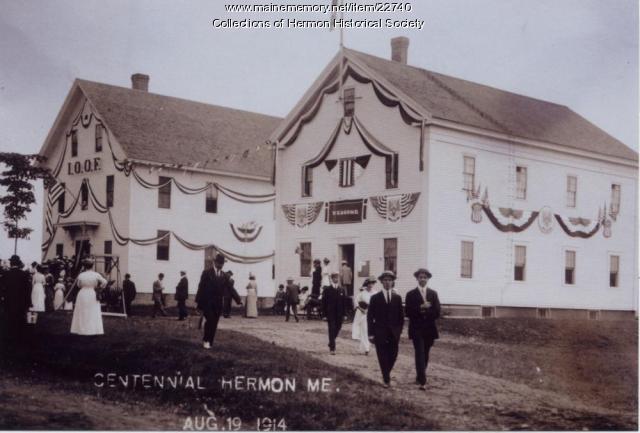Keywords: city building
Item 7395
Old City Building, Lewiston, ca. 1885
Contributed by: Lewiston Public Library Date: circa 1885 Location: Lewiston Media: Phototransparency
Item 14636
First Congregational Church, City Hall, Brewer, ca. 1910
Contributed by: City of Brewer Date: circa 1910 Location: Brewer Media: Postcard
Item 86129
Office, Browns Wharf Office Building, Portland, 1924
Owner in 1924: F E Irwin Lumber Company Use: Office
Item 86133
Lumber Storage and Mill, Brown Wharf Mill Building, Portland, 1924
Owner in 1924: F B Irvin Lumber Company Use: Lumber Storage and Mill
Item 151492
Biddeford City Building, Biddeford, 1898
Contributed by: Maine Historical Society
Date: 1898
Location: Biddeford
Client: City of Biddeford
Architect: John Calvin Stevens
This record contains 25 images.
Item 151693
Portland City Hall site plan, Portland, 1908-1931
Contributed by: Maine Historical Society Date: 1908–1931 Location: Portland Client: City of Portland Architect: Carrere & Hastings Architects
Exhibit
A Snapshot of Portland, 1924: The Taxman Cometh
In 1924, with Portland was on the verge of profound changes, the Tax Assessors Office undertook a project to document every building in the city -- with photographs and detailed information that provide a unique view into Portland's architecture, neighborhoods, industries, and businesses.
Exhibit
A City Awakes: Arts and Artisans of Early 19th Century Portland
Portland's growth from 1786 to 1860 spawned a unique social and cultural environment and fostered artistic opportunity and creative expression in a broad range of the arts, which flowered with the increasing wealth and opportunity in the city.
Site Page
Presque Isle: The Star City - Allen Building
"Now a vacant building, attorney Charles P. Allen built the Allen building in 1890 to house his practice."
Site Page
Presque Isle: The Star City - Historical Buildings
"Historical Buildings Presque Isle's historical buildings express the character and development of the community."
Story
Biddeford City Hall: an in-depth tour of this iconic building
by Biddeford Cultural & Heritage Center Voices of Biddeford project
Visual tour and unique insights of Biddeford’s historical landmark
Story
Alan Casavant-providing leadership during a city's Renaissance
by Biddeford Cultural & Heritage Center Voices of Biddeford project
Evolution of Biddeford's identity through the eyes of a teacher, community servant, and mayor.
Lesson Plan
Building Community/Community Buildings
Grade Level: 6-8
Content Area: Social Studies
Where do people gather? What defines a community? What buildings allow people to congregate to celebrate, learn, debate, vote, and take part in all manner of community activities? Students will evaluate images and primary documents from throughout Maine’s history, and look at some of Maine’s earliest gathering spaces and organizations, and how many communities established themselves around certain types of buildings. Students will make connections between the community buildings of the past and the ways we express identity and create communities today.
Lesson Plan
Longfellow Studies: "The Jewish Cemetery at Newport"
Grade Level: 6-8, 9-12
Content Area: English Language Arts, Social Studies
Longfellow's poem "The Jewish Cemetery at Newport" opens up the issue of the earliest history of the Jews in America, and the significant roles they played as businessmen and later benefactors to the greater community. The history of the building itself is notable in terms of early American architecture, its having been designed, apparently gratis, by the most noted architect of the day. Furthermore, the poem traces the history of Newport as kind of a microcosm of New England commercial cities before the industrialization boom. For almost any age student the poem could be used to open up interest in local cemeteries, which are almost always a wealth of curiousities and history. Longfellow and his friends enjoyed exploring cemeteries, and today our little local cemeteries can be used to teach little local histories and parts of the big picture as well.
Henry Wadsworth Longfellow visited the Jewish cemetery in Newport, RI on July 9, 1852. His popular poem about the site, published two years later, was certainly a sympathetic portrayal of the place and its people. In addition to Victorian romantic musings about the "Hebrews in their graves," Longfellow includes in this poem references to the historic persecution of the Jews, as well as very specific references to their religious practices.
Since the cemetery and the nearby synagogue were restored and protected with an infusion of funding just a couple years after Longfellow's visit, and later a congregation again assembled, his gloomy predictions about the place proved false (never mind the conclusion of the poem, "And the dead nations never rise again!"). Nevertheless, it is a fascinating poem, and an interesting window into the history of the nation's oldest extant synagogue.




















